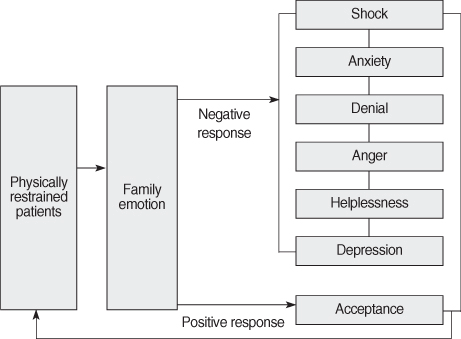Abstract
Purpose
This was a methodological research to develop an instrument to assess the emotional response of family members of physically restrained patients.
Methods
A primary instrument with 68 questions was developed based on literature review and semi-structured interviews with family members. A group of experts revised individual questions and removed 4 irrelevant questions. This secondary instrument, then, was tested with 199 family members of physically restrained patients in intensive care units of a university hospital. The validity and reliability of the instrument were tested by factor analysis.
Results
After item analysis, 3 questions with a correlation coefficient under .30 were discarded and the questions with a factor loading under .45 on Varimax Rotation were also removed. After factor analysis on the final 37 questions, 7 factors were identified; avoidance, shock, helplessness, grudge, depression, anxiousness, and acceptance. The total variance explained was 55.63%. The reliability of this instrument was 0.93 of Cronbach's alpha.
Go to : 
General Characteristics of Subjects (N=199)
CVI of Preliminary Questions
Factor Analysis of 37 Items
Item Analysis of the Final Items
REFERENCES
1. Bower HT. The alternatives to restraint. Journal of Gerontological Nursing. 1991; 17(2):18–22.
2. Choi EH. In: A study on the physical restraint in an ICU. Seoul: Seoul National University; 1999. Unpublishedmaster's thesis.
3. George JE, Quattrone MS. Restraining patients: Can you be sued? Part II. Journal of Emergency Nursing. 1993; 19:57.
4. Hardin SB, Magee R, Vinson MH, Owen M, Hyatt E, Stratmann D. Patient and family perceptions of restraints. Journal of Holistic Nursing. 1993; 11:383–397.

5. Inouye SK, Carpenter PA. Precipitating factors for delirium in hospitalized elderly persons. Predictive model and interrelationship with baseline vulnerability. The Journal of the American Medical Association. 1996; 275:852–857.

6. Janelli LM, Scherer YK, Kanski GW, Neary MA. What nursing staff members really know about physical restraint. Rehabilitation Nursing. 1991; 16:345–348.
7. Jensen B, Hess-Zac A, Johnston SK, Otto DC, Tebbe L, Russel CL, et al. Restraint reduction: A new philosophy for a new millennium. The Journal of Nursing Administration. 1998; 28(7-8):32–38.
8. Kang SH. In: A study on nurses' knowledge and attitude toward the use of physical restraints. Gwangju: Chonnam National University; 2003. Unpublished master's thesis.
9. Kanski GW, Janelli LM, Jones HM, Kennedy MC. Family reactions to restraints in an acute care setting. Journal of Gerontological Nursing. 1996; 22(6):17–22.

10. Kim KS. In: A study on perceptions about physical restraint use of nurses' and doctors' in hospital setting. Seoul: Chung-Ang National University; 2001. Unpublished master's thesis.
11. Kim KS, Kim JH, Lee SH, Cha HK, Sin SJ, Chi SA. The physical restraint use in hospital nursing situation. Journal of Korean Academy of Nursing. 2000; 30:60–71.

12. Kwon SB, Lee M. Factor analysis of the seriously ill patient's family needs. Journal of Korean Academy of Nursing. 1987; 17:122–136.
13. Lee EO, Lim NY, Park HA. In: Statistical analysis and nursing-medical research. Seoul: Soomoon Publishing Company; 1998.
14. Macpherson DS, Lofgren RP, Granieri R, Myllenback S. Deciding to restrain medical patients. Journal of the American Geriatrics Society. 1990; 38:516–520.

15. Mahony DF. Analysis of restraint-free nursing homes. Image-The Journal of Nursing Scholarship. 1995; 27:155–160.
16. Minnick AF, Mion LC, Leipzig R, Lamb K, Palmer RM. Prevalence and patterns of physical restraints use in the acute setting. The Journal of Nursing Administration. 1998; 28(11):19–24.
17. Mion LC, Strumpf N. Use of physical restraints in the hospital setting: Implications for the nursing. Geriatric Nursing. 1994; 15:127–132.
18. Newbern VB, Lindsey IH. Attitudes of wives toward having their elderly husbands restrained. Geriatric Nursing. 1994; 15:135–141.

19. Noh JO. In: An empirical study on the effect of medical service value on the medical customers satisfaction. Jinju: Gyeongsang National University; 2001. Unpublished master's thesis.
20. Park HS, Park ES, Kang IS. In: Nursing Research Methodology. Seoul: Jeongdam Publishing Company; 2000.
21. Park MH. In: Study on the ICU nurses' intention to use restraints and related factor. Daegu: Keimyung National University; 1997. Unpublished master's thesis.
22. Park MH, Lee BS. The use of restraints in ICU of hospitals at Taegu and Kyungbuk area in Korea. Chung-Ang Medicine. 1998; 62:217–227.
23. Rateau MR. Confusion and aggression in restrained elderly persons undergoing hip repair surgery. Applied Nursing Research. 2000; 13:50–54.

24. Seo SH, Lee HY. The development of physical restraints for intensive care unit. Journal of Korean Academy of Adult Nursing. 1996; 8:361–374.
26. Stilwell EN. Nurses' education related to the use of restraints. Journal of Gerontological Nursing. 1991; 17(2):23–26.

27. Strumpf NE, Evans LK. Myths about elder restraint. Image-The Journal of Nursing Scholarship. 1990; 22:124–128.
28. Tabachnick BG, Fidell LS. In: Using multivariate statistics. New York, NY: HarperCollins; 1989.
29. Yeo JM, Park MH. Effects of an education program for nurses on the use of restraints. Journal of Korean Academy of Nursing. 2006; 36:532–541.
Go to : 




 PDF
PDF ePub
ePub Citation
Citation Print
Print



 XML Download
XML Download